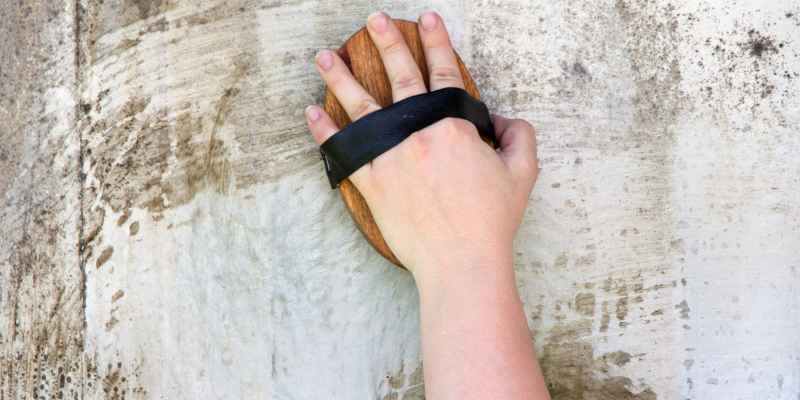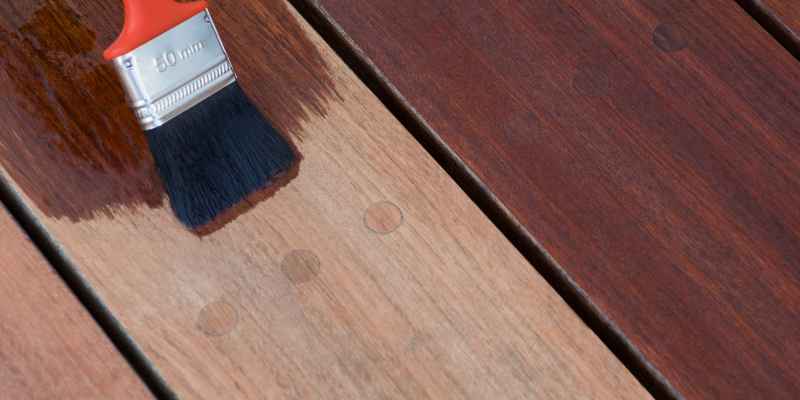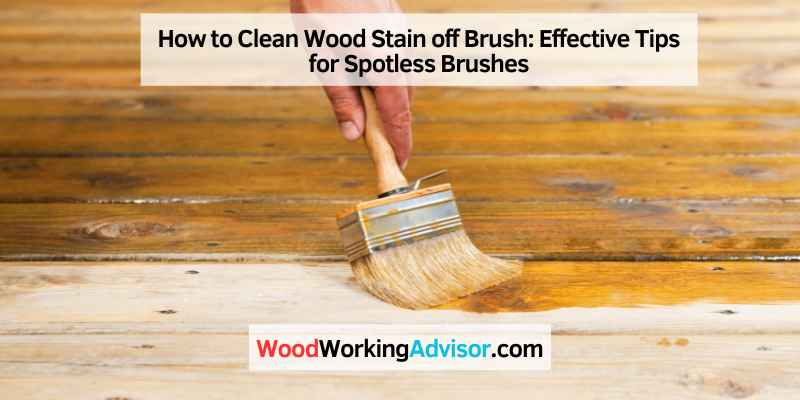To clean wood stain off a brush, soak the bristles in a cup of mineral spirits or paint thinner for a few minutes, then swirl the bristles through the solution and lay the brush flat on a rag. Another method is to use warm, soapy water and wash the brush several times.
Avoid using paint thinners, as they can be harsh and shorten the lifespan of the brush. Some people opt to use walnut or linseed oil to wipe off the stain before rinsing with an oil-based liquid soap like Murphy’s. It’s important to properly clean wood stain brushes to ensure their longevity and proper performance for future use.
Common Methods For Cleaning Wood Stain Off Brushes
When it comes to wood staining projects, cleaning the brushes properly is essential to ensure their longevity and maintain their optimal performance. In this section, we will explore some common methods for cleaning wood stain off brushes. By following these techniques, you can easily remove the stubborn stains from your brushes and keep them in pristine condition for future use.
Using Paint Thinner
- Paint thinners are widely used for cleaning wood stain off brushes due to their high effectiveness.
- Pour a sufficient amount of paint thinner into a container.
- Submerge the stained brush bristles into the paint thinner.
- Gently swirl the brush bristles in the paint thinner for a few minutes.
- Remove the brush from the paint thinner and wipe off any residual stain with a clean cloth or paper towel.
- Rinse the brush bristles with water to remove any remaining paint thinner.
- Leave the brush to air dry before storing it for future use.
Using Mineral Spirits
- Mineral spirits are another popular option for cleaning wood stain off brushes.
- Pour an adequate amount of mineral spirits into a container.
- Dip the stained brush bristles into the mineral spirits.
- Gently agitate the brush bristles in the mineral spirits for a few minutes.
- Remove the brush from the mineral spirits and wipe off any excess stain using a clean cloth or paper towel.
- Rinse the brush bristles with water to eliminate any remaining mineral spirits.
- Allow the brush to air dry completely before storing it for future use.
Using Oil-based Liquid Soap
- For those looking for an alternative to harsh chemicals, using oil-based liquid soap can be a great option.
- Apply a small amount of oil-based liquid soap onto the stained brush bristles.
- Gently work the soap into the bristles, ensuring it reaches all areas with stubborn stain.
- Rinse the brush bristles with water to remove the loosened stain and soap residue.
- Repeat the process if necessary until the brush is completely free from stain.
- Allow the brush to air dry thoroughly before storing it for future use.
By following these common methods for cleaning wood stain off brushes, you can maintain the quality and performance of your brushes, ensuring their longevity and allowing you to achieve excellent results in your wood staining projects.
Effective Techniques To Clean Wood Stain Brushes
Cleaning wood stain off of brushes is a crucial step to ensure their longevity and effectiveness for future use. Using efficient techniques to clean wood stain brushes not only helps maintain their quality but also saves time and money. Here are three effective techniques to clean wood stain brushes:
Soaking In Solvents
Soaking the wood stain brushes in solvents is an effective method to break down and remove the stubborn stains. Begin by placing the brush in a container with the appropriate solvent, such as mineral spirits or paint thinner, allowing the bristles to soak for a few minutes. Ensure proper ventilation while handling solvents. After soaking, gently swirl the brushes in the solvent to further loosen the stain.
Swirling In Cleaning Solutions
- Prepare a cleaning solution by mixing oil-based liquid soap with water, such as using walnut or linseed oil as an environmentally friendly option.
- Swirl the brushes in the cleaning solution, ensuring that the solution reaches every bristle to effectively remove the wood stain.
- Swirling in the cleaning solution helps break down the remaining stain and lift it from the bristles.
Rinsing With Warm Water And Soap
- After the soaking and swirling processes, rinse the brushes thoroughly with warm water to remove any remaining traces of the stain and cleaning solution.
- Use mild soap to further clean the bristles and remove any residual stain or solvent, ensuring that the brushes are completely clean.
Special Considerations For Different Types Of Stains
To clean wood stain off a brush, gently remove excess stain with a rag, then use mineral spirits or turpentine for oil-based stain or warm, soapy water for water-based stain to wash the brush several times. Both dish soap and shampoo can be used for this step.
Oil-based Stains
When cleaning brushes stained with oil-based products, it’s essential to remember that they require specific treatment. Begin with wiping off excess stain using a rag or paper towel. Then, submerge the brush in mineral spirits or paint thinner to dissolve the stain. Swirl the bristles in the solution, remove, and lay the brush flat on a rag to dry.
Water-based Stains
For water-based stains, start by rinsing the brush under warm water to remove as much stain as possible. Gently massage dish soap into the bristles and rinse thoroughly. Repeat the process until the brush is clean. Let it air dry before using it again. It’s crucial to avoid using strong solvents, as they can damage the brush.
Polyurethane Stains
Polyurethane stains demand careful handling. After using the brush, wipe off the excess stain with a cloth. Then, dip the brush in mineral spirits or a specialized brush cleaner for polyurethane stains. Wipe the brush with a clean cloth until no residue remains. Let the brush dry completely before storing it. Ensure proper ventilation while working with mineral spirits.
In conclusion, different types of wood stains require specific cleaning methods to maintain the quality of your brushes. By following the appropriate techniques for oil-based, water-based, and polyurethane stains, you can effectively clean your brushes and prolong their lifespan.

Tips And Tricks For Extending Brush Lifespan
Learn the best tips and tricks for extending the lifespan of your paintbrush by properly cleaning wood stain off of it. Discover effective methods and techniques that will help you keep your brush in top condition for future use.
Using Degreasers Or Dish Soap
When it comes to cleaning wood stain off brushes, using degreasers or dish soap can be an effective method. These cleaning agents help break down the stain and remove it from the bristles. To clean your brush using degreasers or dish soap, follow these simple steps:
- Start by rinsing the brush under warm water to remove any excess stain.
- Apply a small amount of degreaser or dish soap to the bristles.
- Gently scrub the bristles using your fingers or a cleaning brush to work the cleaning agent into the stains.
- Rinse the brush thoroughly under warm water until all the soap or degreaser is removed.
- Pat dry the brush using a clean cloth or paper towel.
Proper Rinsing Techniques
In addition to using degreasers or dish soap, proper rinsing techniques are crucial for extending the lifespan of your brushes. The following steps will help you effectively rinse your brush:
- After cleaning the brush with degreasers or dish soap, hold it under running water.
- Using your fingers, gently squeeze and massage the bristles to remove any remaining stain.
- Continue rinsing until the water runs clear and free of any stain residue.
- Make sure to thoroughly dry the brush before storing to prevent any moisture buildup.
Avoiding Dried Stains
To ensure your brushes last as long as possible, it’s important to avoid letting the stain dry on the bristles. Here are some tips to help you prevent dried stains:
- Immediately after using the brush, rinse it under warm water to remove excess stain.
- If you need to take a break while staining, cover the brush with a plastic bag or wrap it tightly in plastic wrap to prevent the stain from drying.
- If the stain starts to dry on the brush, soak it in a cup of mineral spirits or paint thinner for a few minutes to soften the stain before cleaning.
- Regularly inspect your brushes for any dried stains and clean them promptly to prevent buildup.
Conclusion
By following these tips and tricks for extending brush lifespan, you can effectively clean wood stain off your brushes and ensure they last longer. Using degreasers or dish soap, proper rinsing techniques, and avoiding dried stains are key practices that will help maintain the quality and lifespan of your brushes. With these methods, you can keep your brushes clean and ready for your next wood staining project.
Community Insights And Best Practices
Reddit Discussions
Reddit users have shared valuable tips and tricks for effectively cleaning wood stain off brushes.
Advice For Stain Brush Maintenance
Proper maintenance is essential to prolong the life of your stain brushes.
- Use mineral spirits: Soak the brush bristles in mineral spirits to remove wood stain effectively.
- Wipe off excess stain: Before cleaning, remove any excess stain from the brush.
- Use oil-based liquid soap: Some prefer using walnut or linseed oil for cleaning brushes.
| Tip | Method |
|---|---|
| Tip 1 | Soak bristles in mineral spirits |
| Tip 2 | Wipe off excess stain |
| Tip 3 | Use oil-based liquid soap |
Environmental Impact And Disposal

When cleaning wood stain off a brush, it is crucial to consider the environmental impact and proper disposal methods of the cleaning agents to minimize harm. Understanding sustainable cleaning alternatives and the correct disposal methods for stained brushes can make a significant difference in reducing waste.
Sustainable Cleaning Alternatives:
- Use eco-friendly cleaning solutions
- Opt for natural oils like walnut or linseed oil
- Consider oil-based liquid soaps like Murphy’s
Proper Disposal Methods For Stained Brushes:
- Allow the brush to dry completely
- Dispose of dried brushes in a sealed plastic bag
- Take them to a hazardous waste disposal facility
Frequently Asked Questions For How To Clean Wood Stain Off Brush
Can You Wash Wood Stain Out Of A Brush?
Yes, you can clean wood stain out of a brush using mineral spirits or turpentine for oil-based stains and warm, soapy water for water-based stains.
How Do You Clean Stain Off Of A Paintbrush?
To clean stain off a paintbrush, soak bristles in mineral spirits or warm, soapy water for a few minutes, then swirl bristles and rinse thoroughly.
How Do You Clean Wood Stain Brushes Without Paint Thinner?
To clean wood stain brushes without paint thinner, you can use walnut or linseed oil to wipe off the brushes. If desired, rinse the brushes with an oil-based liquid soap in water. However, keep in mind that cleaning your brushes this way may shorten their lifespan.
Paint thinners are typically the most effective option.
How Do You Clean Brushes After Using Wood Varnish?
After using wood varnish, clean brushes by rinsing them with mineral spirits or paint thinner. Then wash in warm, soapy water and let them dry. Avoid leaving the varnish to dry on the bristles. Regular cleaning extends the brush’s lifespan.
Conclusion
Cleaning wood stain off a brush is a necessary step to ensure its longevity and optimal performance. Using the right techniques and materials, such as mineral spirits or soapy water, can effectively remove the stain without damaging the bristles. Regular cleaning and proper maintenance will extend the life of your brush, allowing you to achieve the best results while working with wood stain.
Remember to rinse the brush thoroughly and use a degreaser or dish soap for the final rinse.


